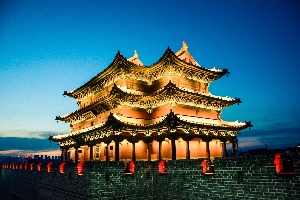Shanxi Travel Guide
Shanxi is one of the birthplaces of the Chinese nation. It has a long history and rich cultural deposits and tourism resources.
When visiting Shanxi, you can explore the ancient city of Pingyao, a renowned cultural hub boasting a 2700-year history, as well as Taiyuan, a modern metropolis steeped in rich historical and cultural heritage. A visit to the Shanxi Museum offers an opportunity to delve into the profound history of Shanxi and gain insights into the splendid culture fostered by its merchants. Furthermore, Wutai Mountain serves as a sacred Buddhist site adorned with numerous ancient temples and grottoes, attracting devout pilgrims and enthusiasts of culture alike. The breathtaking natural scenery includes the awe-inspiring Yellow River Hukou Waterfall – China's second-largest waterfall characterized by its majestic surging waters – while the Yungang Grottoes showcase exquisite Buddhist artistry where each stone carving embodies remarkable craftsmanship and wisdom.
In addition to historical culture and natural landscapes, Shanxi also has a rich and diverse traditional cultural experience. Jin Opera is one of the traditional operas in Shanxi Province. It has a unique performance style and musical form. Shanxi cuisine is also a great pleasure, such as non-staple food, oily meat, and stewed noodles, so that you feel the unique local flavor.
Whether you are interested in history and culture, natural beauty, or traditional culture, here you can meet your needs and enjoy the charm of Chinese tradition. Come to Shanxi, feel the charm of ancient civilization, explore the footprints of history, and leave good memories.
Feature
Chinese: 山西 Shanxi Area: 1507600 square kilometers
Time Zone: UTC+ 8 Population: about 34,660,000
Location: North of China Climate:Temperate continental monsoon climate
Post Code:030000-048000 Administration: Non-autonomous region
Area Code: (+86) 0349-0359 Annual rainfall: 505.8mm
Location of Shanxi Province
Shanxi Province is located in the eastern part of the Loess Plateau, which forms the western region of North China. The landform of Shanxi Province is a mountain plateau covered extensively by loess. Geographically, it has a parallelogram shape stretching from northeast to southwest and shares borders with Inner Mongolia to the north, Henan to the south, Shaanxi to the west, and Hebei Province to the east. It is also near Beijing. The geomorphic types of Shanxi Province are complex and diverse, including mountains, hills, plateaus, basins, and platforms, of which 80% are mountains and hills, and 20% are flat river valleys such as plateaus, basins, and platforms. Most of the area is more than 1,000 meters above sea level, showing an uplift situation compared with the eastern North China Great Plain. The highest point is the Yedou Peak of Wutai Mountain in the northeast, with an altitude of 3,058 meters, which is the highest peak in North China; The lowest point is the southern edge of Yuncheng Yuanqu County southeast West Yang River into the Yellow River, only 180 meters above sea level. The relief from north to south is very significant.

The Shanxi Province is characterized by a mountainous terrain with hills and valleys, forming a distinctive “two mountains and a river” landscape. The eastern and western sides of the province are dominated by uplifted mountains and hills, while the central region consists of a series of interconnected basins interspersed with plains.In the east, Taihang Mountain is the blocky mountain formed by the main vein. From north to south, there are mainly Hengshan, Wutai Mountain, Zhoushan, Taihang Mountain, Taiyue Mountain, and Zhongtiao Mountains, which are tall and majestic, with an altitude of more than 1500 meters. In the west, the Loess Plateau is dominated by the Luliang Mountain. From north to south, there are Qifeng Mountain, Hongtao Mountain, Guankan Mountain, Luya Mountain, Yunshan Mountain, Heicha Mountain, Guandi Mountain, Zijing Mountain, Longmen Mountain, and other major peaks, most of which are above 1500 meters above sea level.
The highest elevation of Guandi Mountain is 2831 meters. In the middle, Datong, Xinzhou, Taiyuan, Linfen, Yuncheng, and other “multi-shape” fault basins are separated from each other from the north to the south. In the southeast, there is a more unique Changzhi Plateau fault basin. The outline of the main body of the province is very much like a “concave” font.
Top Shanxi Tourist Attractions
Yungang Grottoes
 The Yunyang Grottoes
The Yunyang Grottoes
Yungang Grottoes is a national 5A tourist attraction and one of the world's cultural Heritage sites. Together with the Mogao Grottoes, Longmen Grottoes, and Maijishan Grottoes, they are known as the four major grottoes in China, famous for their large scale, diverse themes, exquisite carvings and rich connotations. Yungang Grottoes, founded in 460 AD, is a faithful record of the history, society, culture, national mentality, and customs of the Northern Wei Dynasty, as well as a significant heritage of Chinese Buddhist art. The caves of Yungang Grottoes are diverse in shape and theme, including Buddha statues, Buddhist niches, murals, and other Buddhist art forms. Yungang Grottoes are carved from the mountain, stretching about 1 km from east to west. There are 45 main grottoes and 209 subsidiary grottoes with a carved area of more than 18,000 square meters. The highest statue is 17 meters, and the smallest is 2 centimeters, there are about 1,100 Buddhist niches, the size of more than 59,000 statues. The carving style of Yungang Grottoes integrates Chinese and Western cultures, showing the process of Sinicization of Buddhist art, and its artistic achievements and historical value are widely recognized by the international community.
Mount Wutai
 The Mountain Wutai
The Mountain Wutai
Mount Wutai is one of the four famous Buddhist mountains in China, as well as a world cultural Heritage and national scenic spot. Mount Wutai gets its name from its five high peaks, which are like the five altars, with the highest peak reaching 2,894 meters above sea level. Known as “the first cool mountain”, Mount Wutai has a Buddhist history of more than 1,600 years. Rumor has it that the climate here used to be so harsh, with cold winters and hot summers, that farmers could not get to their fields to grow crops. Manjusri happened to come here to preach, saw the people suffering, and decided to change the climate here. So Manjusri Bodhisattva borrowed a sacred stone from the dragon king and put it in a valley, which was later called Cool Valley, and built temples on both sides of the valley, called Cool Valley, so Mount Wutai is also named for its cool climate. Mount Wutai is the only Buddhist temple in China where Chinese Buddhism and Tibetan Buddhism complement each other. There are 86 places for religious activities, many of which are monasteries and visited by emperors. Famous scenic spots include Xiantong Temple, Pagoda Temple, Bodhisattva Roof, Nanshan Temple, Dai Luoding, and Guangji Temple.
Pingyao Anient City
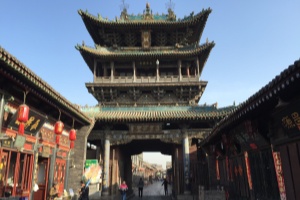 The Pingyai Ancient City
The Pingyai Ancient City
Pingyao Ancient City stands as the most meticulously preserved ancient county town in modern China, embodying the essence of Han nationality urbanism during the Ming and Qing Dynasties. It has conserved all its distinctive characteristics, offering a comprehensive snapshot of the cultural evolution, economic boom, and social and religious growth of the ancient county town in China. The streets and shops of Pingyao Ancient City retain their original historical allure, embodying the urban planning philosophy and spatial distribution of the Ming and Qing dynasties. This further illustrates the evolution of Chinese architectural style and urban design throughout the past five centuries. Serving as an exemplary model for the study of ancient Chinese cities, Pingyao Ancient City boasts a rich and unparalleled value in architecture, religion, commerce, folk customs, and folk art. The majority of buildings in Pingyao exhibit symmetry, boasting intricate wooden, brick, and stone carvings, as well as paper-cut designs that exude a distinct local flavor, further enhancing its charm and allure.After thousands of years of historical changes, Pingyao Ancient city has left its own cultural imprint. Architectural culture, temple culture, religious culture, official culture, Confucian culture and folk culture constitute the cultural characteristics of the ancient city.
Yanmen Pass
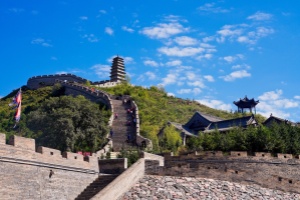 The Yanmenguan Pass
The Yanmenguan Pass
Yanmen Pass, a storied gateway with a history spanning over 3,000 years, dates back to the Warring States period, marking it as an integral component of the Great Wall and renowned as “the First Pass of China(中华第一关).” In ancient times, Yanmen Pass was an important barrier for the Central Plains dynasty to resist the invasion of northern nomads, such as the Xiongnu, Xianbei, Turkic, Khitan, Jurzhen and Mongolia and other northern ethnic groups fought wars with the Han Dynasty here. Yanmen Pass holds not only a significant historical status but also boasts magnificent natural scenery and profound cultural implications. Throughout history, this pass has been a witness to numerous wars, disasters, and acts of bravery, righteousness, and patriotism, further enhancing its status as a symbol of heroism and loyalty.The natural scenery of Yanmen Pass is breathtakingly magnificent, encompassing vast grasslands, continuous mountains, crystal-clear lakes, and canyons that paint a captivating portrait of nature's grandeur. Designated as a national 5A scenic spot, Yanmenguan boasts numerous historical sites and attractions, including the ancient city of Yanmenguan, ancient battlefields, and sections of the ancient Great Wall, all of which offer a profound glimpse into China's rich historical heritage. Yanmen Pass also has a colorful folk culture, such as paper-cutting, embroidery and other folk arts and traditional culture. These cultural heritages not only have historical value and cultural significance, but also provide tourists with a richer travel experience.
Yingxian Wooden Pagoda
 The Yingxian Wooden Pagoda
The Yingxian Wooden Pagoda
Yingxian Wooden Pagoda, also known as Pagoda of Fogong Temple (佛宫寺释迦塔), was built in the Liao Qing Ning two years (1056), It is known as one of the three most remarkable towers in the world, along with the Leaning Tower of Pisa and the Eiffel Tower. The magic is that the whole tower is made of wood, no nails were used when it was built, and the whole tower from the outside appears to be only 5 stories high, but it is actually 9 stories high. The Yingxian Wooden Pagoda enshrines two sacred objects revered by the Buddhist community around the world - Buddha tooth relics, which are confirmed to be the remains of Sakyamuni’s spiritual teeth after research. Many precious cultural relics of Liao Dynasty have also been found in the tower, including manuscripts and Liao Dynasty woodblock prints. In addition, the Yingxian Wooden Pagoda still does not fall after the war and earthquake, which has important research value in the field of earthquake lightning protection and other scientific fields, and is an important coordinate in the history of Chinese architecture.
Datong Ancient City
 The Datong Ancient City
The Datong Ancient City
The Datong Ancient City, situated in the heart of Datong, boasts a remarkable feat of ancient architecture, with its walls constructed during the Northern Wei Dynasty, spanning a history of over 2,000 years. This city stands as a testament to the enduring legacy of ancient Chinese civilization, offering a glimpse into its rich historical past. The Distinctive Characteristic of the Datong Ancient City lies in its Multi-Layered Historical Fabric, Encapsulating the Richness of Various Dynasties. The innermost layer is the rammed earth construction of the Northern Wei Dynasty, followed by the Liao and Jin-reinforced rammed earth. The outermost black bricklayer represents the construction of the Ming Dynasty. This integration of rammed earth across different dynasties is a testament to the profound history and culture of the ancient city.The city wall is square, 1.8 kilometers long from east to west, 1.82 kilometers long from north to south, 7.24 kilometers in circumference, and 3.28 square kilometers in area. The ancient city of Datong is not only famous for its majestic city walls but also has a rich historical and cultural heritage, such as Huayan Temple, Shanhua Temple, Daiwang Mansion, and other famous Buddhist temples and ancient buildings. These scenic spots have unique historical value and cultural connotations. There are many ethnic groups living in the ancient city, among which the Han and Hui are more, forming a folk custom with local characteristics.
Xuankong Temple
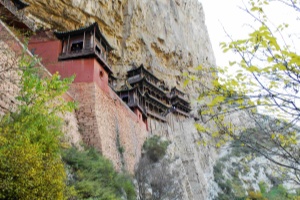 The Xuankong Temple
The Xuankong Temple
Xuankong Temple like a temple hanging on a cliff, the temple was built in the late Northern Wei Dynasty (491), has a history of more than 1,500 years, is a unique combination of Buddhism, Taoism and Confucianism temples. The whole temple is a wooden frame structure, which cleverly uses mechanical principles to support and connect. The interior of the temple is adorned with copper, iron, stone, and mud, housing over 80 Buddha statues. This intricate blend of materials and mechanical precision is a testament to the remarkable craftsmanship and engineering of the temple. It is composed of the South Tower, the North Tower, and the long-line bridge. The statues of Xuankong Temple are mainly distributed in the Lei Yin Hall at the top of the South Tower. The main hall is dedicated to the three sages of Huayan (Avalokitesvara, Puxian, and Manjusri), and there are other statues around them, including pavilions and attics, and 24 phones and 18 arhats. The building not only integrates Chinese garden architecture art but also loses the pattern of traditional Chinese architecture.
The Hukou Waterfalls of Yellow River
 The Hukou Waterfalls of Yellow River
The Hukou Waterfalls of Yellow River
Hukou Waterfall is the second-largest waterfall in China, the largest yellow waterfall in the world, and a national 5A scenic spot. The Hukou Waterfall arises due to the Yellow River's sharp narrowing at this particular point, resulting in a dramatic drop from a width of approximately 400 meters to just 20 meters. This constriction causes the turbulent river to rush downward with immense force, creating a magnificent waterfall that is truly breathtaking. With a width of up to 50 meters and a height of about 20 meters, the waterfall is known as the “heart of the Yellow River(黄河之心)” because of its magnificent scenery and rich historical and cultural connotations. The scenery of Hukou Waterfall transforms with each passing season, offering a new vista at every season. In spring and summer, the rainy season brings an abundance of water, resulting in a magnificent display of falling waters. Autumn brings clarity to the water, painting the waterfall in vibrant hues, while winter transforms the water surface into a frozen canvas, presenting a majestic ice storm. Beyond its natural beauty, this waterfall carries profound cultural significance, having been revered as a spiritual symbol of the Chinese nation since ancient times.
Xiaoxitian Temple
 The Xiaoxitian Temple
The Xiaoxitian Temple
The whole temple construction area of more than 1100 square meters, built Mahavira Hall, Manjusri Hall, Hall of General Virtues, bell tower, drum tower, and many other halls, Mahavira Hall is the main hall, in less than 170 square meters of Mahavira Hall, there are nearly 2000 statues, tall to 3 meters, small as the thumb, almost arranged in addition to doors and Windows outside all the walls and pillars. These colorfully painted sculptures not only adorned the front and gable walls of the main hall but also hung from or wound around beams and columns, creating a world of Buddhism that delivered a strong visual impact. The architectural style and characteristics of Xiaoxitian can be summarized by the four adjectives: “small, skillful, delicate, and extraordinary.” Here, sculptures of every size, even as small as a thumb, could be found.
Feihong Pagoda
 The Feihong Pagoda
The Feihong Pagoda
The Feihong Pagoda, a pagoda-style tower city, was first constructed in the Eastern Han Dynasty and has undergone several reconstructions since then. Standing at a height of 47.31 meters, the tower is decorated with various colored glazed tiles externally and hollow inside. With a perimeter of 136 meters at the bottom, its silhouette tapers upward, resembling a cone. The entire glazed tower shines brilliantly in the sun, resembling a rainbow hence the name Feihong Padoda. Currently, the Feihong Tower is not only the best-preserved glazed pagoda in China but also the tallest glazed pagoda in the world. Moreover, it served as one of the filming locations for the scene where Tang Monk climbs the tower in the 1986 version of Journey to the West, making it highly valuable both historically and artistically. The glazed tiling of the Feihong Tower reflects the superb glazing techniques and wisdom of the Shanxi people, making it a representative of Chinese glazed pagodas and a valuable research subject in architecture and art.
Baquan Groge
 The Baquan Groge
The Baquan Groge
Baquan Gorge Scenic Spot is a national 5A tourist attraction. The gorge is about 11 kilometers long from north to south, covers an area of 24.11 square kilometers, the highest altitude of more than 1700 meters, and has a maximum drop of 1100 meters. Baquan Gorge Scenic area is dominated by a canyon landscape with steep mountain walls and gurgling water on both sides of the canyon. In the scenic area, visitors can see different forms of canyon landscape, such as the Yixian sky(一线天), Shuangmen cave(双门洞), Sanqing cave(三清洞), and so on to form a magnificent canyon scene.
Hengshan Mountain
 The hengshan Mountain
The hengshan Mountain
Hengshan Mountain is one of the five mountains in China, together with Mount Taishan in the East, Mount Hua in the west, Mount Hengshan in the south, and Mount Songshan in the middle. Hengshan has a long history and splendid culture, and the word “恒(Heng)” in Chinese means constant. Tianfengling, the highest peak of Hengshan, is 2016.1 meters above sea level. Hengshan is a sacred place of Taoism, here the temples are concentrated and very large scale, mainly Hengzong Hall, Hui Xian Mansion, Nine Heavenly Palace, and other ancient buildings. In addition to the temple buildings on Mount Hengshan, the cliff carvings are also a major attraction, which can be seen everywhere on the cliffs, the most famous of which is the word “恒宗(Heng zong)” on the cliffs. Hengshan not only has many cultural relics, but also the natural landscape is spectacular. Here the autumn scenery is pleasant and the trees are dyed, just like walking into a painting. Hengshan Mountain is not only full of cultural relics but also has a spectacular natural landscape. The autumn colors and forests here are so pleasant that it is like walking into a painting.
Qiaojia Grand Courtyard
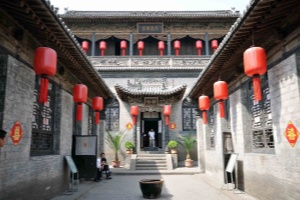 The Qiaojia Grand Courtyard
The Qiaojia Grand Courtyard
Qiaojia Grand Courtyard consists of 6 courtyards, 19 courtyards, and a total of 313 houses, is a majestic architectural group, with a total of three major expansions, from the initial construction to the formation of the final pattern has experienced two centuries. Qiaojia Grand Courtyard is an ancient house with the northern traditional residential architecture style, which reflects the unique style of Chinese Qing Dynasty residential architecture. Qiaojia Grand Courtyard is exquisitely designed and exquisitely crafted, which has high ornamental, scientific research, and historical value. Qiaojia Grand Courtyard also has more than 5,000 precious cultural relics, reflecting the folk customs mainly in Jinzhong, Shanxi Province, including agricultural customs, life rituals, seasons, clothing, food, housing, business customs, folk crafts.
Visit Shanxi with Reliable Travel Agency
Thanks to its large size, Shanxi is not flooded by visitors even in the peak seasons compared to other travel destinations. You will not need to join a queue for entering the spots.
To better explore Shanxi, choose a reliable travel agency will help you make your dream tour come ture.
We are here to provide you unforgettable tours! We have been devoted to the inbound tourism for more than 20 years, with 98% 5-star review on TripAdvisor.
We will provide you the best service and price to guarantee you a great Shanxi holiday.
Waiting for you in our hometown! :)



















